Recent Articles
Popular Makes
Body Types
2025 Subaru Forester Road Test and Review
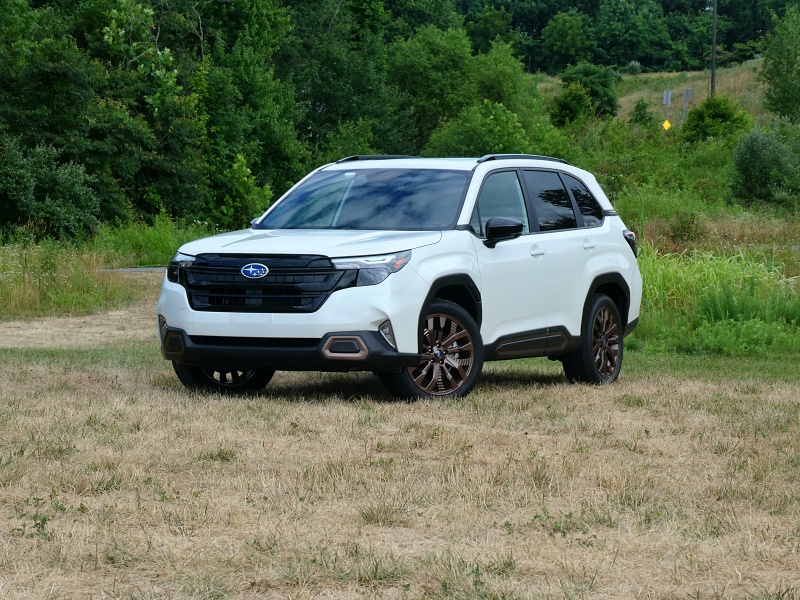
2025 Subaru Forester Sport ・ Photo by Brady Holt
Sometimes, a redesigned car is a revolution. An automaker might pull out all the stops to address longtime complaints, or it might reimagine it as a different type of vehicle. With these drastic changes, loyalists are sometimes uneasy about losing what they always loved about their cars.
With the redesigned 2025 Subaru Forester, prior owners have nothing to worry about. The new Forester retains nearly all the same strengths – and weaknesses – as the version sold from the 2019 to 2024 model years. We just spent a week testing the 2025 Forester, priced from $29,695, to evaluate its pros and cons and see how it stacks up in the compact crossover segment. Keep reading to see what we thought of it and whether it sounds like the right small SUV for you.
What's New
The biggest change to the 2025 Forester is its styling details. While the old model was cheerfully angular, the new Forester is smoothed out for a gentler, more upscale look. Big, rounded-off headlights merge into the grille, and the rounded taillights slip into a slim lightbar spanning the rear of the vehicle. A small connection between the rear window and rear windshield introduces the “floating roof” effect that was trendy about seven years ago. And our tested midlevel Sport model now has bronze wheels. Overall, the new Forester’s details have changed but aren’t going to grab attention. And the Forester’s size and upright, boxy silhouette and large front overhang have barely budged.
Under the new skin, Subaru says it stiffened its platform for a smoother, quieter ride; retuned the engine and transmission; made the all-wheel-drive system respond faster; redesigned the steering system for quicker, more natural responses; upgraded its EyeSight suite of advanced safety features; and added new features that include an available hands-free power liftgate and ventilated front seats. Subaru also redesigned the dashboard, which we’ll discuss in a moment.
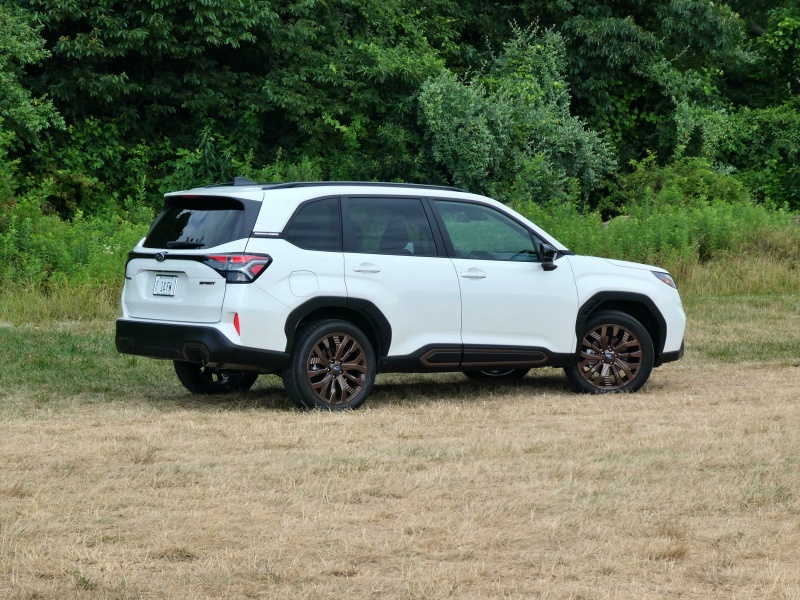
2025 Subaru Forester Sport ・ Photo by Brady Holt
Big New Touchscreen
The 2025 Subaru Forester’s interior will look familiar to anyone who’s been in the brand’s latest Crosstrek, Outback, or Ascent SUVs. They all have a vertical 11.6-inch touchscreen in the middle of the dashboard, and the new Forester follows suit in all but its base trim level – replacing last year’s choice of 6.5-inch and 8-inch screens. (The base 2025 Forester has two 7-inch screens, one above the other, separated by a strip of physical controls.)
Subaru’s infotainment system isn’t our favorite in the industry; some views are cluttered, the system isn’t always lightning-fast to respond to inputs, and some of the big screen is given over to climate controls that would work better as real buttons and knobs. But overall, the new Forester has a more modern interior vibe while retaining the sturdy simplicity of the previous overall interior layout. Also, many basic controls remain easy to use, and the screen supports Android Auto and Apple CarPlay smartphone integration.
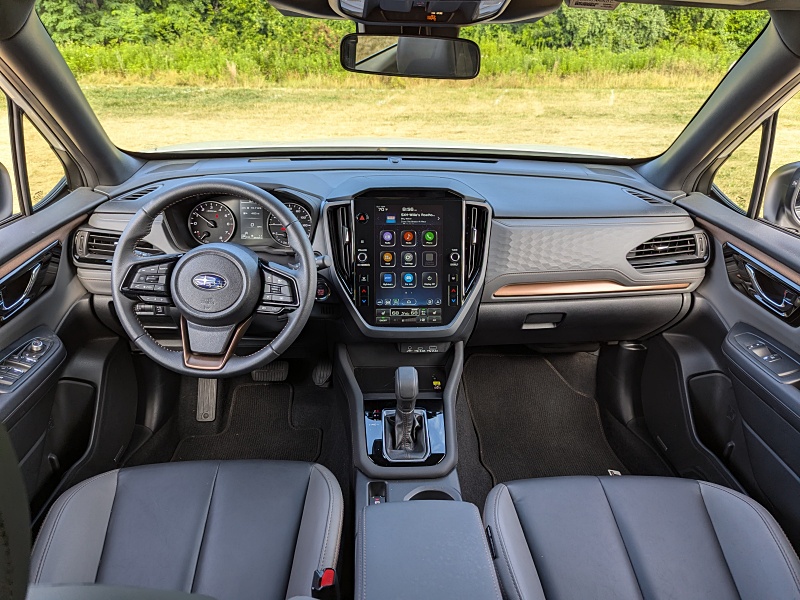
2025 Subaru Forester Sport ・ Photo by Brady Holt
Still Plenty of Space
The new Forester’s similar size and shape means a similarly spacious interior to the previous generation. That means ample legroom and headroom for both front and rear passengers. Yet if big cars intimidate you, it still feels natural to slip behind the wheel of a Forester. Plus, large windows and thin roof pillars give it the least-impeded visibility of any modern car – a boon for low-stress driving.
Cargo capacity on most Foresters measures 27.5 cubic feet behind the rear seat and 69.1 cubic feet with the rear seat folded down. That’s a useful amount of space, though most competitors have even more. The base-model Forester, which doesn’t include a roof-lowering sunroof, has a few extra cubic feet for when you've loaded the car up the ceiling. All new Foresters can tow up to 1,500 pounds, which doesn’t cover a huge trailer but is typical for a small crossover.
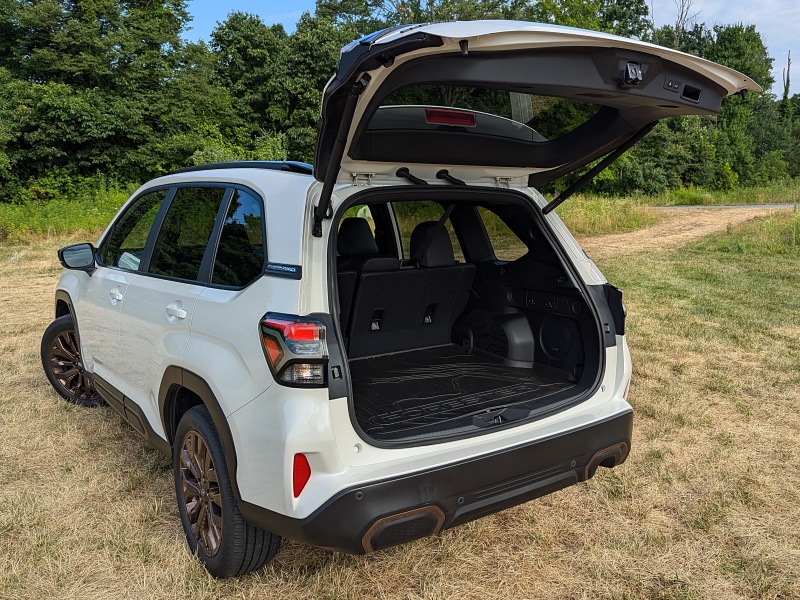
2025 Subaru Forester Sport ・ Photo by Brady Holt
Easy Driving Manners
The Forester’s comfortable, easy manner extends to its driving dynamics. The suspension prioritizes taking the edge off bumps rather than extra-buttoned-down body motions or handling agility, even in our tested Sport model. The latest steering system is easy and natural, but it doesn’t inspire you to explore the Forester’s handling limits (which are lower than you’d find from a Mazda CX-50, Ford Escape, or Nissan Rogue). A 180-horsepower 2.5-liter four-cylinder engine mated to a continuously variable automatic transmission (CVT) is the only available powertrain. It’s quieter than in past Foresters, but marginally so, and no speed demon. It feels natural to drive the Forester gently, but when you put your foot down for more power, this SUV hardly seems to notice. Overall, the Forester feels compact and easy to drive, but it’s neither a performance car nor a luxury one.
Another familiar Forester characteristic is its off-road capability. Subaru’s symmetrical all-wheel-drive system is standard equipment, as is a high 8.7-inch ground clearance. And all but the base model include X-Mode, which includes specific settings for dirt and snow or (on upper trims) mud and deep snow. It also provides hill-descent control, which helps manage your speed on steep low-speed slopes. However, Subaru hasn’t yet redesigned the Forester’s extra-capable Wilderness model.
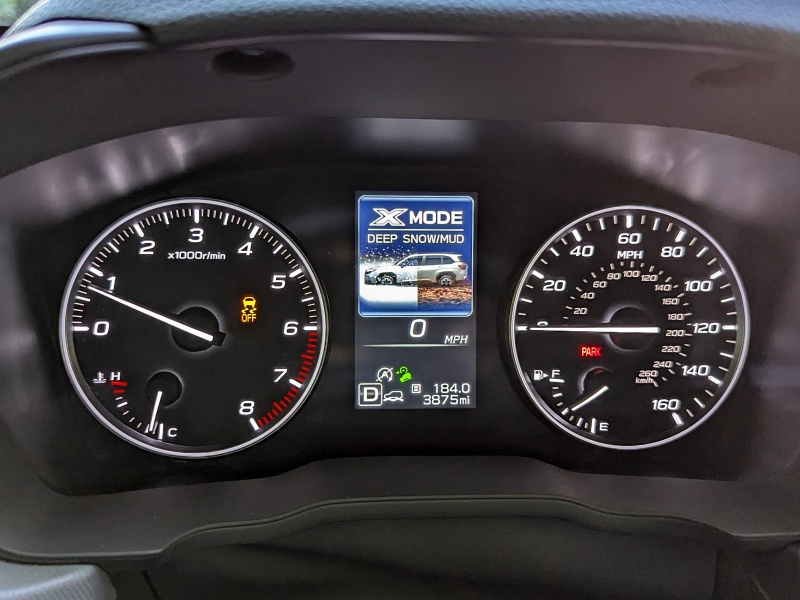
2025 Subaru Forester Sport ・ Photo by Brady Holt
Decent Gas Mileage, With a Hybrid on the Way
Most 2025 Subaru Forester models get an EPA-estimated 26 mpg in the city, 33 mpg on the highway, and 29 mpg combined – the same as the 2024 Forester – while Sport and Touring trim levels with bigger wheels drop by 1 mpg. Our Sport test vehicle edged out the EPA rating to average 29 mpg in a week of mixed driving.
That’s pretty good gas mileage for the class, among the upper tier of gas-only compact crossovers. Only the Nissan Rogue, with an ultra-sophisticated three-cylinder turbo engine, does much better (by about 2 mpg). However, many popular competitors are available with gas-electric hybrid powertrains that boost gas mileage well into the 30s – especially in the stop-and-go conditions that are the hardest on gas engines. Subaru says a Forester Hybrid, likely borrowing some technology from the best-selling Toyota RAV4 Hybrid, should go on sale next year.
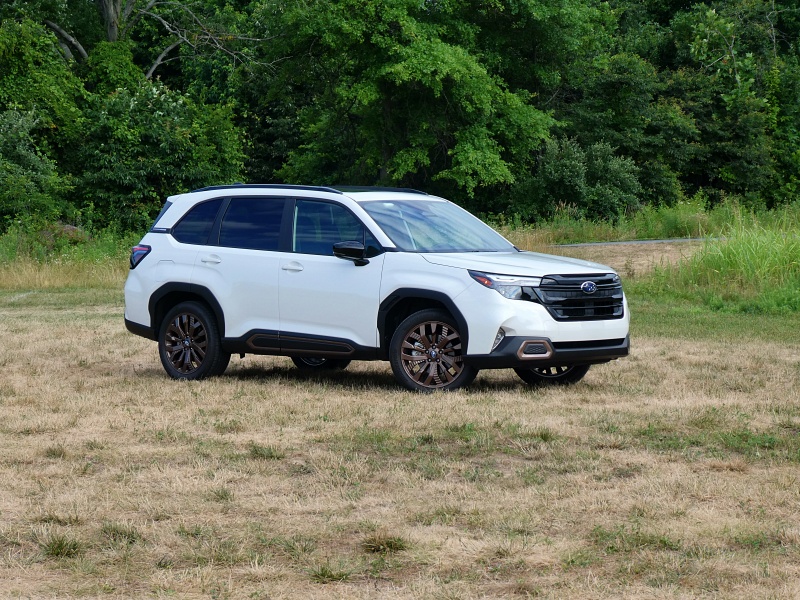
2025 Subaru Forester Sport ・ Photo by Brady Holt
Expect Another Safety Winner
Last year’s Forester earned five out of five stars from the National Highway Traffic Safety Administration and earned a Top Safety Pick status from the Insurance Institute for Highway Safety. We expect similar excellence from the new model once it's tested.
The Forester also comes packed with advanced safety features. Subaru’s EyeSight driver-assistance suite is standard, bringing forward automatic emergency braking, adaptive cruise control, a lane-departure warning, and lane-keeping steering assistance. However, for such a safety-conscious brand, Subaru is stingy with some features. Blind-spot monitoring (paired with automatic evasive steering assistance to swerve around an obstacle) isn’t available on the base Forester and costs extra on the next-up Premium trim level. (Thank goodness for the excellent visibility!) And reverse automatic braking costs extra on the mid- and upper-level Sport and Limited trims, and it’s only standard on the top Touring.
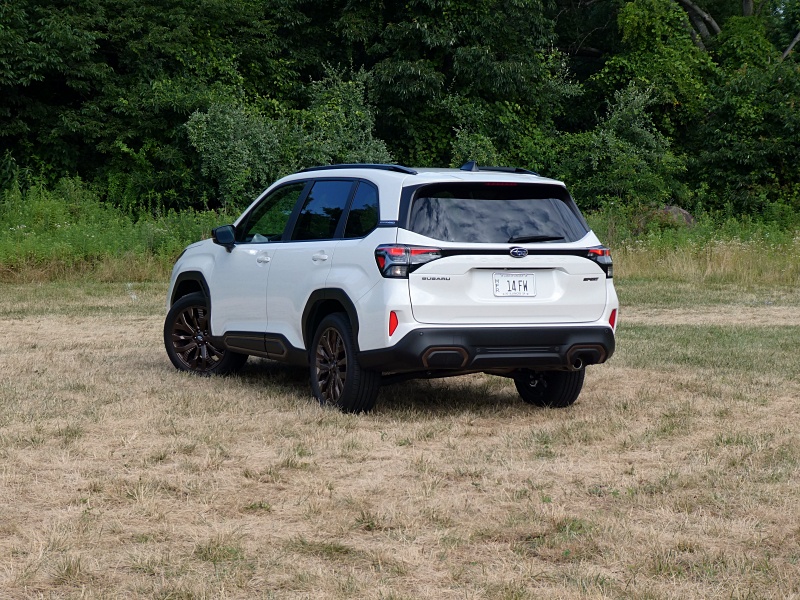
2025 Subaru Forester Sport ・ Photo by Brady Holt
Prices Have Risen
The Forester used to be one of our favorite budget-friendly small SUVs. But even as some desirable features cost extra or are left to pricier trim levels, the Forester’s prices have jumped with its redesign. As we mentioned, it now starts at $29,695 – that’s up nearly $3,000 from last year’s $26,895.
This is still a competitive price when you consider that, unlike most competitors, the Forester comes standard with AWD. It’s about $1,500 to $2,000 extra on most rivals. (On the other hand, it means you can’t opt to save that cash by keeping front-wheel drive.) The next-up Premium model – with a sunroof, a heated power driver’s seat, the bigger infotainment screen, X-mode, and optional blind-spot monitoring – starts at $31,995. The Sport like our test vehicle ($34,995) has dressier styling, water-resistent leatherette upholstery, and standard blind-spot monitoring. The top Limited ($35,995) and Touring ($39,995) have genuine leather, a heated steering wheel, a hands-free power liftgate (optional on the Premium and Sport), and a power passenger’s seat. The Touring’s exclusives are memory settings for the power driver’s seat, ventilated front seats, a driver-attention monitor, heated rear seats, and some optional features from the Limited: GPS navigation, rear automatic braking, and a Harman Kardon stereo.
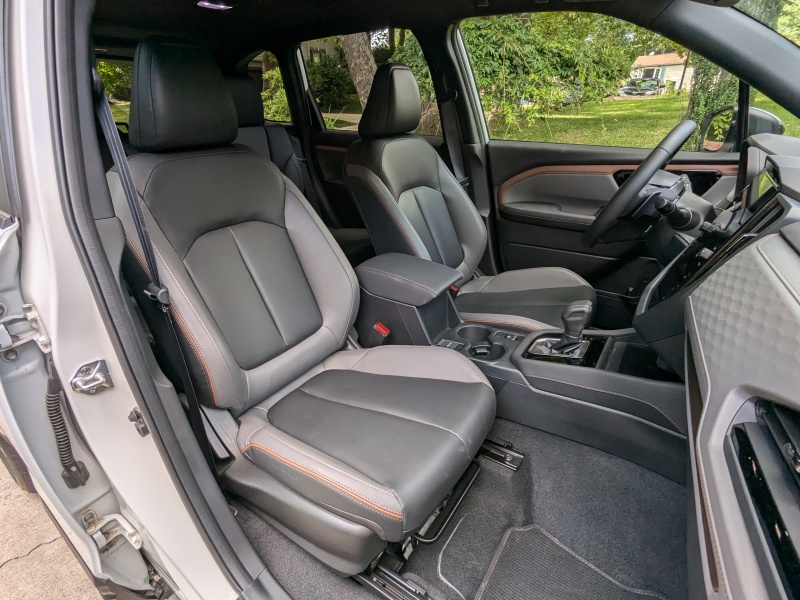
2025 Subaru Forester Sport ・ Photo by Brady Holt
Plenty of Competitors
Especially at its higher prices, the Forester faces a slew of competitors. Rivals with a similarly outdoorsy vibe include the best-selling Toyota RAV4, the Jeep Compass, the Ford Bronco Sport, and the Mazda CX-50. Of these, the Forester is roomier and more economical than all but the RAV4, and we prefer how the Subaru drives over the Toyota. However, all of these rivals are available with more powerful engines than the Forester, and the Ford and Mazda have sportier handling as well.
Other leading compact crossovers with less rugged capability than this Subaru include the Hyundai Tucson and Kia Sportage twins (roomier, flashier, and less economical than the Forester); the Nissan Rogue (a more luxurious but more complex machine); and the Honda CR-V (bigger and fancier than the Forester, but also more expensive). We’d also look hard at the smaller Subaru Crosstrek to see if it’s big enough for you; the Forester’s price jump makes the Crosstrek’s $25,195 starting price a lot more attractive. Meanwhile, the Forester now costs even more than Subaru's mid-size Outback. That's a bulkier and more wagon-shaped crossover, but it's roomier and feels more expensive than the Forester.
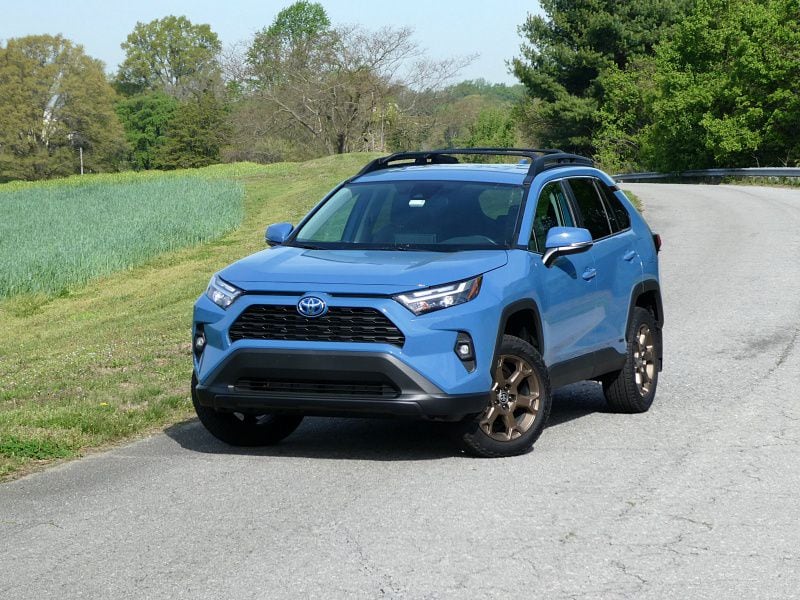
2023 Toyota RAV4 Hybrid Woodland Edition ・ Photo by Brady Holt
A Familiar Forester
The 2025 Subaru Forester should be familiar to anyone who’s owned this popular SUV in the past decade. It’s a simple, comfortable, functional transportation machine for everyday drives, messy weather, and unpaved roads.
This year’s price increase stings. But if you prioritize simplicity over maximum luxury, performance, and technology, the Forester remains a leading compact crossover – budget pricing or not.

2025 Subaru Forester Sport ・ Photo by Brady Holt